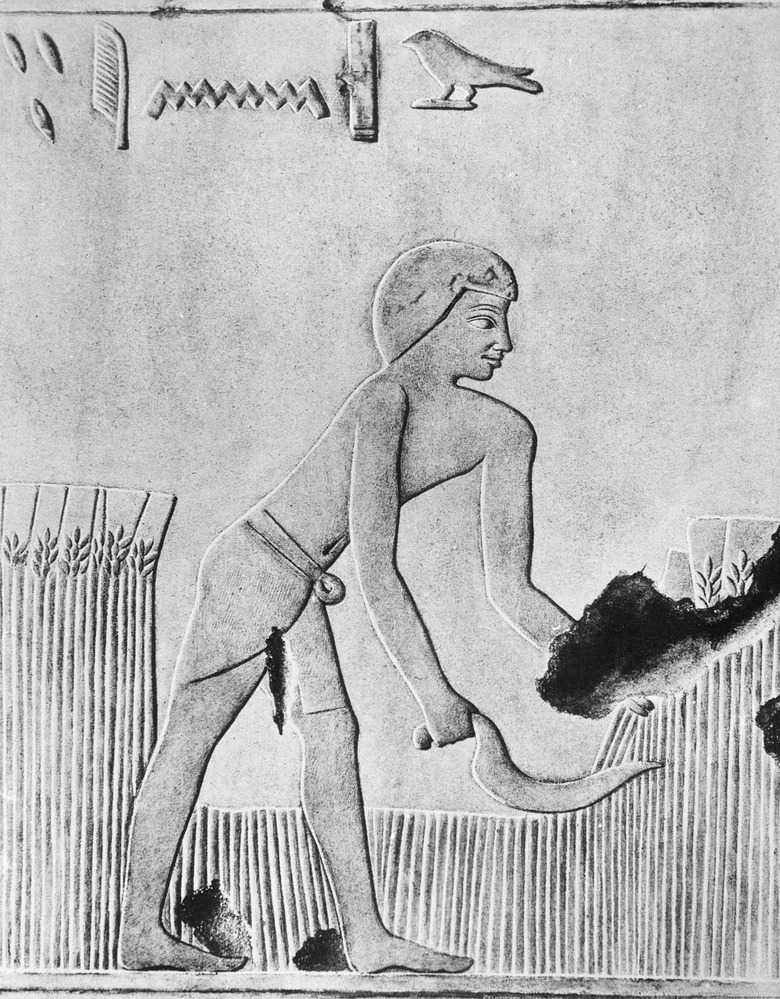Harvesting In Ancient Egypt
Civilizations on the Nile lived and died by the whims of the river that played such a central role in their world. Egypt was, and is, a desert, with little if any farmland and long stretches of the year when water is just not available. The annual flood was the one respite from this harsh reality, and by learning to take advantage of its reliable regularity, the ancient Egyptians were able to create a successful agricultural society.
Harvest Time
Harvest Time
Harvest time in the Nile River Valley occurred between April and June, depending on the weather. The harvest preceded the wet summer season when the river floods from June through October. The flood brought new silt, minerals and nutrients to the lands surrounding the river, which in turn created the fertile soil necessary for a successful crop. The Egyptian harvest depended on the flood season to replenish the soil. If the floods did not come, or the river acted unpredictably in any other way, the crops could fail, and the harvest could be diminished, or not occur at all. Without a successful harvest, many Egyptians would have gone hungry, and their economy would have collapsed.
The Flood
The Flood
Since the Nile River flows from south to north toward the equator, the annual floods originated south of Egypt in Ethiopia. This annual flood fueled the harvest, but ancient Egyptians saw more potential in developing ways to move water to places where it would have the greatest impact. They installed irrigation systems near Cairo using fresh water springs as their source. They also installed dams in southern Egypt to divert the Nile waters and increase the depth of the river itself. This allowed both for an increase in arable land and the ability to travel further into the African continent by ship with greater ease.
Crops
Crops
The ancient Egyptians were great producers of wheat and other grains, including emmer, barley and flax. Each was used in daily life, from baking bread and brewing beer to crafting ropes or cloth. They shipped excess grains abroad and traded for other goods. They grew the castor oil plant for lubrication and papyrus for writing material. Corn may have been the largest crop overall, and remains so today. It was the grain local residents used for food and trade purposes. Although corn may or may not have always yielded full crops on a yearly basis, it remained a staple thanks to its long storage life.
Manual Labor
Manual Labor
Ancient Egyptians used animal power as the primary means of technology in the farming process. They used animals like cattle and horses to pull ploughs and turn the soil for planting. If farmers were without animals, they did the ploughing by hand. Since the new silt deposits were not very deep, the work was not overly difficult. Egyptians used camels and asses to transport water and goods, but not as draught animals for farming work. These animals grazed in the pastures surrounding the river. Clover was the main animal food crop and remains so today.
References
- Berkeley: Farming and agriculture of Egypt and Mesopotamia
- The British Museum: Ancient Egypt: A Nobleman's Family
- Tehuti Egypt Research Foundation: The Ancient Egyptian Superior Farming Techniques
- Massachussets Institute of Technology: Egyptian Agriculture
- The Oriental Institute of the University of Chicago: Ancient Egypt: Farming
Cite This Article
MLA
Morello, Robert. "Harvesting In Ancient Egypt" sciencing.com, https://www.sciencing.com/harvesting-ancient-egypt-8915/. 24 April 2017.
APA
Morello, Robert. (2017, April 24). Harvesting In Ancient Egypt. sciencing.com. Retrieved from https://www.sciencing.com/harvesting-ancient-egypt-8915/
Chicago
Morello, Robert. Harvesting In Ancient Egypt last modified March 24, 2022. https://www.sciencing.com/harvesting-ancient-egypt-8915/
